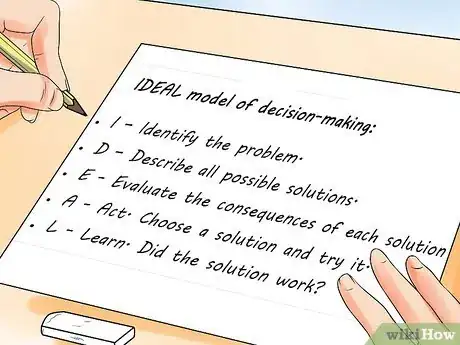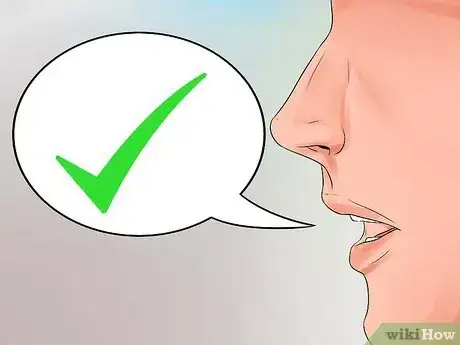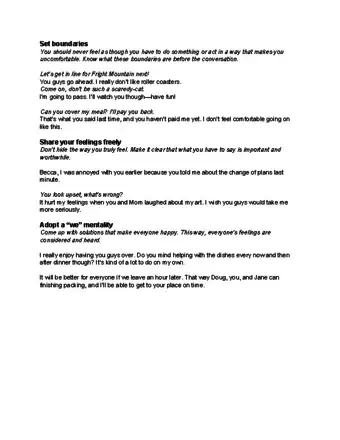This article was co-authored by Jessica Notini, JD. Jessica Notini is a Negotiation and Mediation Coach practicing in California and internationally in many Latin countries. She is also a Lecturer at Stanford Law School and an Adjunct Professor at Boalt School of Law, Hastings College of the Law, and Mills College's MBA Program. She is the past Chair of the California State Bar Alternative Dispute Resolution Committee, served as the President of the Association for Dispute Resolution of Northern California (formerly NCMA), and was a member of the Board of Directors for the Mediation Society of San Francisco. She was recognized for her leadership and years of dedication with the California Dispute Resolution Council’s 2012 Don Weckstein Award. She has a BA in Psychology from Wesleyan University and a JD from the University of Michigan.
There are 9 references cited in this article, which can be found at the bottom of the page.
wikiHow marks an article as reader-approved once it receives enough positive feedback. This article received 18 testimonials and 86% of readers who voted found it helpful, earning it our reader-approved status.
This article has been viewed 1,431,832 times.
Being assertive falls right in the middle of being passive and aggressive. If you're passive, you'll never get to vocalize your needs; if you're aggressive, you'll look like a big bully and will likely be misdirecting your frustrations. But if you're assertive, you'll be able to express your desires while respecting the needs of others, and you'll have a better chance of getting what you want and deserve.
Steps
Understanding the Difference between Assertiveness, Aggression, and Passiveness
-
1Understand assertive communication. Assertive communication carries respect for the feelings, needs, wants, and opinions of others. An assertive communicator avoids infringing upon the rights of others, while asserting their own, seeking compromise in the process. Assertive communication utilizes actions and words to express boundaries of needs and wants in a calm fashion, while conveying a message of confidence.[1]
-
2Learn verbal features of assertive communication. The verbal cues that indicate assertive communication convey respect, sincerity and firmness. These cues might include:
- Firm, relaxed voice
- Fluent and sincere
- Appropriate volume for situation
- Cooperative and constructive
Advertisement -
3Learn the non-verbal features of assertive communication. Just like verbal cues, non-verbal communication conveys assertive behavior and can indicate respect, sincerity and confidence. Non-verbal features might include:
- Receptive listening
- Direct eye contact
- Open body stance
- Smiling when pleased
- Frowning when angry
-
4Learn thoughts associated with assertive communication. An assertive person will naturally gravitate towards certain thought patterns that indicate their confidence and respect for others. These thoughts might include:
- “I won’t be taken advantage of, or attack another person.”
- “I will stand up for myself in a respectful manner.”
- “I will express myself directly and openly.”
-
5Understand aggressive communication. Assertiveness can often be incorrectly confused with aggression. Aggressiveness lacks respect for others. It is a complete disregard for the needs, feelings, wants, opinions, and sometimes even the personal safety of other people. Aggressive communication can often be identified by angry and/or demanding behavior, self-promotion, and manipulation.
- Verbal features of aggressive communication might include: sarcastic or condescending remarks, blaming, shouting, threats, boasting, or the use of put-downs.
- Nonverbal features of aggressive communication might include: intruding upon others’ personal space; fist-clenching, crossed arms, scowling, or staring down another person.
- Thoughts associated with aggressive communication might include: “I feel powerful, and will get others to do my bidding," "I am in control of other people," or "I refuse to be vulnerable.”
-
6Understand passive communication. Silence and assumption are the hallmarks of the passive communication style. Passive communicators often lack respect for themselves, disregarding their own opinions, feelings, needs, and desires. Passive communication places one’s own needs and desires below those of others. Passivity takes away one’s power and allows others to decide the outcomes of situations:
- Verbal features of passive communication might include: hesitancy, quiet, self-dismissal, or self put-downs.
- Non-verbal features of passive communication might include: averting the gaze or looking down, slouched posture, crossed arms, or covering the mouth with hand.
- Thoughts associated with passive communication might include: “I don’t count," or “People will think poorly of me.”
- Note that being passive is not the same thing as being passive-aggressive, which is characterized by agreeing in the moment and then being resentful or retaliatory later.
-
7Think about your influences. From early childhood, our behaviors are adapted to fit responses received from our environment, families, peers, coworkers, and authority figures. Communication styles, such as passiveness, assertiveness, and aggression, can be extensions of cultural, generational, and situational influences. Assertiveness is much more valued in Western societies.
- Older generations may find it more difficult to act assertively. Men were once taught that emotional expression was a sign of weakness, while women were taught that stating their own needs and opinions conveyed messages of aggression. Sometimes, it can even be difficult for us to discern which behaviors are appropriate to use in different situations.
-
8Do not blame yourself for your communication style. It is important not to blame yourself if you do not understand how to communicate assertively. Other types of communication styles, such as passiveness and aggression, can be parts of a vicious cycle. You can break this cycle by learning new assertive ways of thinking and behaving.
- If your family taught you to place the needs of others before yourself as a child, it may be difficult for you to assert yourself.
- If your family or peer group handled conflict by yelling and arguing, you may have learned to deal with conflict accordingly.
- If your social group believed that negative emotions should be concealed, or if your have ever been ignored or ridiculed for expressing these types of feelings, then you may have learned not to communicate negative emotions.
Gaining Insight into Your Emotions
-
1Start writing in a journal. In order to learn how to communicate assertively, it is important that you learn how to effectively manage your emotions. For some, just gaining insight into their own emotional processes can be enough to help them change the way they communicate with others and enable them to express their emotions in a more assertive manner. Keeping a journal can be the best to get to the bottom of your behavior, by recording situations and asking specific questions that relate to assertiveness.
-
2Identify situations as if you were filming a scene. Write down situations that trigger your emotions. Stick to facts and try not to make any interpretations in this first step. For example, you may simply write, “I asked my friend to go out to eat, and she said ‘no’.”
-
3Identify the emotions you were feeling in the situation. Be honest about how you felt. Specify what emotions you were aware of at the time, and rate the intensity of each emotion on a scale from 0 to 100 (not intense at all to extremely intense). Just give an estimate but be honest with yourself.
-
4Identify your behavior in reaction to the situation. Note any physical symptoms you may have felt at the time. Ask yourself, “What did I do?” and “What did I feel in my body?”
- For example, if someone ignored your phone call, maybe you felt sick to your stomach or tension in your shoulders.
-
5Identify thoughts that you had while in the situation. These thoughts may be assumptions, interpretations, beliefs, values, and so forth. Ask yourself, “What was I thinking?” or “What was going through my head?” For instance, you may write down: “I agreed to go out to eat when she asked me, so she should have said yes when I asked her,” or “Saying no was rude of her,” or “Maybe she doesn’t want to be my friend anymore.”
-
6Rate the strength of each thought. Again using the 0 to 100 scale, rate the strength of your thoughts in the situation. Record a “0” if you didn’t believe the thought, or a “100” if you believed it 100%. Then ask yourself, “Am I thinking in a passive, assertive, or aggressive manner?” Record your response to this question. Record any evidence for, or against, each thought. Evaluate whether there may be other ways to interpret the situation.
-
7Determine a more assertive response to this situation. In order to find a more balanced and assertive manner of thinking and behaving, ask yourself, “What would be a more assertive way of thinking or responding?”
-
8Re-rate your original emotions. After you have evaluated the situation, revisit the intensity of your original emotions and the strength of your beliefs in the situation. Rate them again from 0 to 100.
-
9Try to journal regularly. Through the journaling exercise, you are likely to decrease the intensity of your emotions. Evaluate your emotions, thoughts, and reactions during different types of situations. If you continue to practice, you may begin to think and behave in a more assertive manner.
Learning to Communicate Effectively
-
1Understand the benefits of assertive communication. Assertiveness is a learned style of communication that allows for the confident expression of one’s needs and feelings while, at the same time, remaining mindful of the opinions, wants, needs, and feelings of others. It is an alternative to behaving in a passive or aggressive manner. There are many benefits to learning how to communicating assertively:[2]
- Strong and effective communication
- Confidence
- Self-esteem enhancement
- Gain respect of others
- Improves decision-making skills
- Reduces stress of not having needs met
- Enables conflict resolution
- Self-respect increases
- Feelings of being ignored or coerced replaced by feelings of being understood and in control of decisions
- Tendency to be less depressed
- Decreased likelihood of substance abuse
-
2Say “no” when appropriate. Saying no can be difficult for many people. However, saying “yes” when you need to say “no” can lead to unnecessary stress, resentment, and anger toward others. When saying no, it can be helpful to keep in mind a useful set of guidelines:
- Keep it brief.
- Be clear.
- Be honest.
- For example, if you don't have time to do a favor that you don't have time to do, you can simply say, "I can't this time. Sorry to disappoint you, but I have too many things to do that day, and there's no room in my schedule."
-
3Stay calm and respect others. When you are speaking with someone, remain calm and have respect for them. This will enable the other person to heed what you say and treat you with respect too.
- It may help to breathe deeply if you start to feel upset. Doing so will initiate your body's calming process and help you stay in control.
-
4Use simple sentences. Communication may seem like a simple task, however, much of what we attempt to communicate to others – and what is communicated to us – can often be misunderstood. This may cause frustration or conflict in our relationships with other people. When communicating with someone, state your feelings, wants, opinions, and needs in simple sentences. This will help the other person clearly understand what you’re asking.[3]
- For example, instead of speaking to a family member in long sentences full of hints and indirect statements, you can be brief and direct: "I love when you call me just to talk! It's hard for me to have a long conversation during work hours, though. I'd appreciate it if you called during the evening instead."
-
5Utilize “I” statements when you are asserting yourself. “I” statements convey that you are willing to take responsibility for your own thoughts and behaviors. There are different types of “I” statements that are appropriate for a variety of situations:
- Basic assertion: This type of “I” statement can be used in everyday situations to make your needs known, or to give praise, information, or facts. Basic assertions can also be utilized in self-disclosure situations to ease anxiety and enable relaxation. It includes: “I need to leave by 6 o’clock,” or “I enjoyed your presentation.”
- Empathetic assertion: This particular “I” statement contains elements of recognition of another person’s feelings, needs, or desires, as well as a statement of your own needs and desires. It can be used to indicate your sensitivity to another person’s position, such as, “I know you are busy, but I need your assistance.”
- Consequence assertion: This is the strongest form of “I” statement, often used as a last resort assertion. It can be misinterpreted as aggressive if you are not careful to observe your non-verbal behavior. The consequence assertion informs another person of the penalties for not changing their behavior; usually in situations when someone is not considering the rights of others. An example would be a work situation when procedures or guidelines are not being followed: “If this happens again, I am left with no choice but to pursue disciplinary action. I would prefer to avoid that.”
- Discrepancy assertion: This type of “I” statement is used to point out a discrepancy between what has been previously agreed upon, and what is actually happening. It is used for clarifying misunderstandings and/or contradictions in behavior. You might say, “As I understand, we agreed that Project ABC was our number one priority. Now you are asking me to allow more time for Project XYZ. I would like you to clarify which is now the top priority.”
- Negative feelings assertion: This form of “I” statement is utilized in situations where you feel negative feelings toward another person (anger, resentment, hurt). It enables you to convey these feelings without making an uncontrolled outburst, and alerts the other party of the effects of their actions. You might say, “When you procrastinate on your report, it involves my working over the weekend. I feel annoyed by this, so in the future I would like to receive it by Thursday afternoon.”
-
6Use appropriate body language. Always remember when being assertive, your non-verbal communication is important. It is possible to think you are acting assertively when you are actually being passive or aggressive because you are not careful about your non-verbal communication style.
- Keep your voice calm and volume neutral
- Maintain good eye contact
- Relax your face and body position
-
7Take time to practice assertive communication. Adopting assertive behavior takes time and practice so that it can become second nature to you. Practice having conversations in the mirror. Alternately, practice your conversation with your therapist or counselor.
Learning to Manage Stress
-
1Acknowledge stress in your life. It can be challenging to keep your emotions under control, which can affect the way we communicate. When we get stressed or upset, our bodies go into stress mode, which puts our bodies into a chemical and hormonal reaction to get ready for a perceived threat.[4] The way you think in this state is different than the way you would think with a calm, clear, rational mind and body, making it more difficult for you to use your assertiveness techniques.
- Acknowledge when you have stress in your life. Make a list of the things that are contributing to your stressful state.
-
2Try meditation. Relaxation techniques bring our bodies back to a balanced physiological state. For example, meditation has a calming effect on the brain that lasts well after your meditation session. This has a direct effect on the amygdala, the center in the brain responsible for emotional reasoning.[5] Try to meditate every day for at least 5-10 minutes.[6]
- Sit in a comfortable chair or on a pillow.
- Close your eyes and focus on sensations that you’re having. Pay attention to what you feel with your body, what you hear, and what you smell.
- Turn your attention to your breathing. Inhale for a count of four, hold your breath for a count of four, and exhale for a count of four.
- Whenever your mind wanders, dismiss the thoughts without judgment and refocus your thinking on your breath.
- You might add a mantra or metta, or a saying that uplifts you and gives you positive feelings, such as, “May I be peaceful,” or “May I be happy.”[7]
- You might also try a guided meditation, which helps you visualize relaxing imagery.[8]
-
3Practice deep breathing. When you are in a stressful situation, deep breathing can help reduce stress and help you think clearly. Take some deep breaths by slowly and deliberately inhaling and exhaling.
- Sit comfortably in a chair with your arms and legs uncrossed, feet flat on the floor, and hands resting on your thighs. Gently close your eyes.
- Breathe in through your nose, observing the quality of the breath while inhaling and exhaling.
- Slowly lengthen each inhalation by smoothly deepening each breath down into your abdomen. Pause briefly, then note the smooth, steady breath released as you exhale.
- Begin counting the rhythm of your breaths. Inhale for 3 seconds. Exhale for 3 seconds. Maintain slow, even, and controlled breathing. Try not to speed up.
- Use this rhythm while breathing for 10-15 minutes
- When finished, gently open your eyes. Relax momentarily. Then, slowly rise from the chair.
-
4Try progressive muscle relaxation. If you’re nervous about meditation or feel you don’t have the time to practice it faithfully, the relaxation response can still be activated through progressive muscle relaxation.[9] This technique activates the body’s calming response and brings the body back into physiological balance by tensing and relaxing each muscle group in the body in progression. To practice progressive muscle relaxation in about 15-20 minutes per day:
- Find a comfortable position in a chair with your feet flat on the floor, your hands resting on your thighs, and your eyes closed.
- Start the exercise by clenching your fists, holding for 10 seconds. Then release, feeling the relaxation sensation for another 10 seconds. Repeat.
- Tense your lower arm by bending your hand downward at the wrist, hold for 10 seconds. Release, and relax for another 10 seconds. Repeat.
- Work through the rest of your body, pausing to tense and relax each muscle group. Start with your upper arms, shoulders, neck, head, and face. Then continue with your chest, stomach, back, buttocks, thighs, calves and feet.
- When you’ve worked through your entire body, sit for a few minutes to enjoy the sensation of feeling relaxed.
- Stand slowly to avoid dizziness (blood pressure drops when relaxed) or tensing up again unexpectedly.
- If you don’t have 15-20 minutes to complete the entire exercise, you can practice on muscle groups that are noticeably tense.
Making Decisions Effectively
-
1Use the IDEAL model of decision-making. Making decisions is part of being assertive. You are taking control of your life and making decisions that best suit you, rather than letting someone else make decisions for you or allow yourself to become swayed by someone else against your better judgment. By identifying the problem, you will be able to address critical elements that result in good decision-making. Niagara Region Public Health recommends using the IDEAL model:
- I – Identify the problem.
- D – Describe all possible solutions. These might include handling it yourself, asking for intervention from someone else, or doing nothing.
- E - Evaluate the consequences of each solution. Evaluate your feelings and needs to determine the best outcome for yourself.
- A - Act. Choose a solution and try it. Use “I” statements to express your feelings and needs.
- L - Learn. Did the solution work? Evaluate why or why not. If it didn’t work, look at the other solutions on your list and work through them.
-
2Consider who needs to be involved. There may be multiple parties who will be impacted by a decision, but not all of them necessarily have to be involved with the decision-making. Get input from those who need to be involved.
- You should consider the other parties as you make your decision, but the final say will come from you.
-
3Understand the purpose of your decision. All decisions are prompted by the need for some course of action. Take time to determine the purpose behind this course of action. This will ensure that the decision is the correct one.
-
4Make a timely decision. Procrastination can be a major impediment to assertive decision-making. Don’t leave the decision to the last minute or you may eliminate some of the possible solutions.
Setting Healthy Boundaries
-
1Protect your physical and emotional space. Boundaries are the physical, emotional, and intellectual barriers that you create to protect yourself from harm. Healthy boundaries protect your personal space, self-esteem, and maintain your ability to separate your own feelings from those of others. Unhealthy boundaries increase your likelihood of exposure to being adversely affected by others feelings, beliefs, and behaviors.[10]
-
2Plan out your boundaries. When you go into a conversation where you want to discuss your needs, it’s important to know your boundaries beforehand. Having your boundaries at the forefront of your mind before a conversation will keep you from getting derailed and compromising your needs in the middle of a conversation because it's easier or helps you avoid conflict.
- For example, establish a boundary with your boss of not working on the weekends or not working overtime without three days’ notice. If you're talking to a friend, have a boundary of not picking her up at the airport again until she picks you up when you need a ride.
-
3Learn to say no. If you do not feel right doing something, then don't do it. It's okay to reject someone. Remember, for yourself, the most important person is you. If you don't respect your own desires, how can you expect others to?
- You may think that being a people-pleaser will put you on people’s good side, but unfortunately, an overabundance of generosity usually has the opposite effect on people.
- People only value the things they invest time/energy/money into, so if you’re the one doing all the giving, your esteem for that person will skyrocket, but theirs for you will decline. Take a stand. People may resist at first – or even be shocked by your transformation – but in the end, they will respect you for it.
-
4State your own opinions in a respectful manner. Don't be silent if you have something to say. Share your feelings freely: it's your right. Remember, there's nothing wrong in having an opinion. Just make sure you pick the right moment to state your needs. Make it clear that what you have to say is important and should be noticed.
- Practice in low-stakes situations. Do all your friends love that new TV show everyone’s talking about? Don’t be afraid to admit that you weren’t all that impressed. Has someone misinterpreted what you said? Don’t nod and play along; explain what you really meant, even if the miscommunication was harmless.
-
5Identify what your needs are. Identify what makes you happy and what your needs are. This will help you develop a set of expectations for other people to follow in how you would like to be treated. Think of situations where you don’t feel like you’re being treated with mutual respect or situations where you felt like your feelings were not being considered. Then consider what could happen to make you feel more respected.[11]
-
6Be honest with yourself about what you want. Acting confidently won’t do you any good if you can never make up your mind or are trying too hard to “go with the flow.” People will be accommodating to your needs if you can tell them clearly what those needs are.
- Off-loading decision-making onto everyone else is a passive-aggressive way of shirking your responsibility – and placing the consequences squarely on someone else’s shoulders. The next time your friends ask you where you want to go to dinner, don’t respond with, “Oh, wherever”; give them a concrete answer.
-
7Come up with solutions that make both parties happy. A good approach is to adopt a “we” mentality and come up with solutions that will make both parties happy, if the situation allows. This way, everyone’s feelings are being considered and heard.
- For instance, if you drive your roommate to work every day, yet she doesn’t pay for gas, approach her about this issue. You can say, “I don’t mind giving you rides every so often. Owning a car is really expensive, though, and I am saving you money and time if you were to take the bus to work every day. Would you mind chipping in for gas every week? I’d really appreciate it.” In this way, you are acknowledging that she might not realize that you feel a certain way. Now she is aware of the problem without you using an accusing tone.
Projecting Confidence
-
1Evaluate your level of self-confidence. Self-confidence is reflected by your ability to understand how you see yourself. This includes your self-perception and where you believe you fit in the social hierarchy. If you see yourself in a negative light, you might experience great difficulty asserting your own thoughts, beliefs, needs, and feelings. Furthermore, you may feel intimidated or reluctant to ask questions when you need clarification, focus too heavily on your own negative traits, and lack trust in yourself. Self-doubt prevents assertive communication. Assess your self-confidence through self-evaluation by asking yourself these questions:[12]
- Can you maintain eye contact when communicating with others?
- Do you project your voice properly?
- Do you speak confidently (without using the phrases “uh” or “um” frequently)?
- Is your physical posture or stance erect and open?
- Do you have the ability to ask questions when clarification is needed?
- Are you comfortable around other people?
- Are you able to say no when appropriate?
- Are you able to express anger and annoyance appropriately?
- Do you offer your opinion when in disagreement with others?
- Do you defend yourself against mistakes that are not your fault?
- If you answered no to 3 or fewer of these questions, you are likely a self-assured individual. If you answered no to 4-6 of these questions, there is a significant chance that you see yourself negatively. If you answered no more to than 7 questions, you are likely to experience tremendous difficulty with self-confidence. You may often doubt your worthiness of respect or see yourself lower in the social hierarchy.
-
2Have confident body language. The way you hold yourself speaks volumes about you – long before you even get a chance to open your mouth. Keep your shoulders squared and your chin up. Avoid fidgeting (put your hands in your pockets if you must) or covering your mouth when you speak. Look people in the eye when you speak to indicate that you don't intend to be brushed off.
- Try not to be easy to read, especially if you are nervous or uncertain. Hide your “tells” by controlling your hands, feet, and facial expressions so that they don’t betray your emotions.
- If making eye contact is a problem, practice with sunglasses and then work up to doing it barefaced. If you must avert your gaze, look off into the distance as if in thought, not down.
- Even if you are nervous or confused, you can still act confident. There's no shame in asking questions.
-
3Speak clearly and deliberately. Rushing when you talk is an admission that you don’t expect people to take the time to listen. Speaking slowly, on the other hand, will indicate to people that you’re worth the wait. Use a clear, calm voice. You don't need to be loud, but you do need to make yourself heard.
- If people aren't noticing you, say "Excuse me" clearly and firmly. Don’t be apologetic when you haven’t done anything wrong, as this can communicate to people that you feel slightly embarrassed just for existing.
- Try to be concise when you speak. Even the most confident person in the world will lose their audience if they don’t make their point soon enough.
- Avoid saying um or like as much as you can when you're trying to make a strong statement. Make a conscious effort to get these words out of your vocabulary.
-
4Work on your appearance. Shallow though it may be, people make snap judgments based on your appearance. People who are naturally confident and charismatic can change others’ minds, but the rest of us aren’t so lucky. If you're wearing clothes that look like you've just got out of bed, or if you wear a pound of make-up with fluffy high-heels, the average person won't take you seriously. On the other hand, if you look like you're ready to get things done, people will tend to be more respectful.
- Dressing well doesn’t necessarily mean dressing up. If you’re the naturally casual sort, focus on having clean, matching, unwrinkled clothes with no embarrassing slogans or inappropriate images.
- Making an effort to be serious about your appearance will make it look like you're more serious about your demands.
-
5Rehearse what you're going to say. This may sound silly, but if you want to project confidence, then you should sound firm and decisive when the moment comes. What better way to get there than to practice? You can practice in front of the mirror, into a recording, or even with a trusted friend, pretending he or she is your boss, significant other, or whomever you plan to speak with.
- When the moment comes, remember how confident you sounded when you were just rehearsing, and work to sound even more confident when it counts.
Seeking Additional Help
-
1Visit a counselor or psychologist. If you feel you still need help becoming assertive, it can help to see a professional. Counselors and psychologists have education and training specifically in helping people communicate in healthy and meaningful ways.
-
2Try assertiveness training. Many universities offer assertiveness training to the students. This will help you practice assertiveness techniques while helping you discuss different situations where you feel you need help in being assertive, as well as help in controlling your stress as you navigate different situations.
-
3Practice with a trusted friend. Asserting yourself takes practice and time. Ask a friend to help you practice your communication skills in various scenarios. The more you face situations that demand assertiveness, even when they are mock situations, the more confident you will become.
Help Sounding Assertive
Expert Q&A
-
QuestionHow can I be more assertive with a boss at work?
 Jessica Notini, JDJessica Notini is a Negotiation and Mediation Coach practicing in California and internationally in many Latin countries. She is also a Lecturer at Stanford Law School and an Adjunct Professor at Boalt School of Law, Hastings College of the Law, and Mills College's MBA Program. She is the past Chair of the California State Bar Alternative Dispute Resolution Committee, served as the President of the Association for Dispute Resolution of Northern California (formerly NCMA), and was a member of the Board of Directors for the Mediation Society of San Francisco. She was recognized for her leadership and years of dedication with the California Dispute Resolution Council’s 2012 Don Weckstein Award. She has a BA in Psychology from Wesleyan University and a JD from the University of Michigan.
Jessica Notini, JDJessica Notini is a Negotiation and Mediation Coach practicing in California and internationally in many Latin countries. She is also a Lecturer at Stanford Law School and an Adjunct Professor at Boalt School of Law, Hastings College of the Law, and Mills College's MBA Program. She is the past Chair of the California State Bar Alternative Dispute Resolution Committee, served as the President of the Association for Dispute Resolution of Northern California (formerly NCMA), and was a member of the Board of Directors for the Mediation Society of San Francisco. She was recognized for her leadership and years of dedication with the California Dispute Resolution Council’s 2012 Don Weckstein Award. She has a BA in Psychology from Wesleyan University and a JD from the University of Michigan.
Negotiation & Mediation Coach In that case, you don't want to frame the assertion like, "You need to get with the program and do it my way," because clearly that wouldn't work out very well. Instead, try to get on the same page with them and focus on a shared interest or goal that you both care about. For example, you could focus the conversation on how you want to make sure the project gets done on time or within budget and that's why you're suggesting doing things differently than what your boss initially asked for or wanted.
In that case, you don't want to frame the assertion like, "You need to get with the program and do it my way," because clearly that wouldn't work out very well. Instead, try to get on the same page with them and focus on a shared interest or goal that you both care about. For example, you could focus the conversation on how you want to make sure the project gets done on time or within budget and that's why you're suggesting doing things differently than what your boss initially asked for or wanted.
Warnings
- In confrontations, emotions can run high. Remember to be respectful and keep a cool head.⧼thumbs_response⧽
- Not insertive, assertive.⧼thumbs_response⧽
References
- ↑ Murphy, J. (2011). Introduction. In Assertiveness: How to stand up for yourself and still win the respect of others. Kindle Books.
- ↑ Murphy, J. (2011). Introduction. In Assertiveness: How to stand up for yourself and still win the respect of others. Kindle Books.
- ↑ http://www.helpguide.org/articles/relationships/effective-communication.htm
- ↑ http://dujs.dartmouth.edu/fall-2010/the-physiology-of-stress-cortisol-and-the-hypothalamic-pituitary-adrenal-axis#.VM_XLy4epPI
- ↑ http://news.harvard.edu/gazette/story/2012/11/meditations-positive-residual-effects/
- ↑ http://www.tarabrach.com/howtomeditate.html
- ↑ http://www.tarabrach.com/howtomeditate.html
- ↑ http://www.mayoclinic.org/tests-procedures/meditation/in-depth/meditation/art-20045858
- ↑ http://www.health.harvard.edu/mind-and-mood/relaxation-techniques-breath-control-helps-quell-errant-stress-response
- ↑ http://www.selfgrowth.com/articles/Boundaries_the_importance.html
- ↑ http://www.selfgrowth.com/articles/Boundaries_the_importance.html
- ↑ Murphy, J. (2011). Chapter 1: How do you see yourself? In Assertiveness: How to stand up for yourself and still win the respect of others. Kindle Books.
About This Article
If you want to be assertive, speak in a firm, relaxed voice at a volume that fits the situation. Maintain an open body stance and direct eye contact to demonstrate confidence. Additionally, try to use simple sentences when you’re conveying thoughts and feelings, which can help you avoid misunderstandings. It’s okay to say “no,” as long as you’re calm and respectful about it. Finally, practice having conversations in a mirror so being more assertive becomes second nature to you. For more suggestions from our reviewer on being assertive, including setting healthy boundaries, scroll down!















































































































